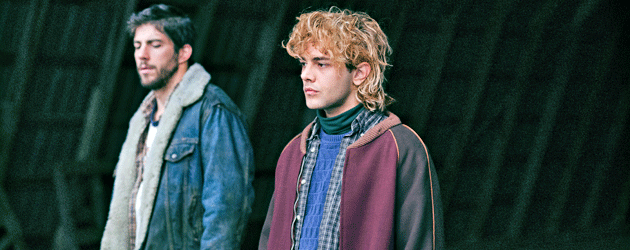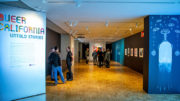
out director/actor Xavier Dolan, whose new movie, Tom at the Farm, opened Aug. 14.
All Photos: Amplify Releasing
Out director talks hot farm boys, directing Kathy Bates and Susan Sarandon, and dropping the ‘gay film’ label
By: Chris Azzopardi*/Special to TRT—
Xavier Dolan is fulminating against the gay tag that typically accompanies his revered art films.
Though indies such as Laurence Anyways, I Killed My Mother and Mommy have earned Dolan substantial queer cred, sexuality-based pigeonholing has been irksome for the 26-year-old cinema prodigy. Surely, however, it hasn’t stopped him from moving beyond those perceived barriers.
His big break is just around the corner: Dolan has two projects in the hopper featuring Hollywood notables. Marion Cotillard is taking on the role of Catherine in Dolan’s It’s Only the End of the World, while The Death and Life of John F. Donovan, which he’s also directing, attracted Oscar winners Kathy Bates and Susan Sarandon.
But first he’s making his press rounds for Tom at the Farm, an eerie drama centered on a young man (Dolan) asked to keep his sexuality on the DL while staying at his dead lover’s mother’s farm.
Q. Tom at the Farm mingles grief with sexual desire. Why do you think sometimes these two emotions converge, and what drew you to explore that hybrid on screen?
A. I’m glad you’re bringing that up because I remember on set saying it’s gonna be an extreme mixture of violence and emotion. I feel like when you watch a thriller you are not emotionally stirred – you are anxious or you are scared – and then when you watch an emotional movie, you are rarely scared or freaked out. I saw that it could be an interesting way of approaching a thriller, to combine these emotions, not that I think this film is especially emotionally stirring, but it’s a little morose, a little blue, in the beginning. Characters are indeed grieving, and there are moments of sincere emotions toward the end with the mother. It was all about finding a balance. I think that happened quite organically on set, and it was pretty clear to me when was the right time for which emotion.
Q. There’s a real sexual intensity between Tom and the brother in this film, and this lingering feeling that they’ll get it on.
A. You know what? It was originally planned as such. We shot a scene, but I feel like in the end it wasn’t what the movie was about. It wasn’t about romance; it was about something else. It was about a theme that is larger than sexual desire, even though it’s cool and, you know, sort of a nice supporting narrative to add tension, but it wasn’t something that needed closure or needed to actually happen for real.
Q. It’s the big tease of the movie. Was that gay / pseudo-straight attraction influenced by any real-life desirability of your own?
A. (Laughs) I wish! My life is not that exciting. I honestly wish that I had known that sort of barbaric, savage, brutal tension… with such a man… on a farm. But, unfortunately, no; I’m afraid my romances are much more urbane.
Q. Why were you drawn to Tom at the Farm?
A. I saw the play and the cinematic potential was just very, very obvious. I immediately saw that this could be a very exciting thriller and a very exciting endeavor for me. The story itself was fascinating and very interesting, but then I was excited to explore something new – the newness in everything was what was most appealing.
Q. And it strays from your typical style.
A. It’s sort of an outcast in the rest of the ensemble. But you know what? I’ve been dreaming about doing another thriller. I really am looking right now.
Q. One of your next projects is The Death and Life of John F. Donovan, starring Kathy Bates, Susan Sarandon and Jessica Chastain. Isn’t that like the ultimate gay filmmaker’s dream?
A. I mean, Kathy Bates, Jessica Chastain, Susan Sarandon – it’s a dream come true. Kathy Bates is just, honestly… who doesn’t love her? She’s an icon. She’s so, so good. Same goes for Susan Sarandon. Both were part of my childhood. And Jessica is literally the first actress who reached out to me and said, “I want to work with you,” and who showed me kindness and generosity in a very surprising and rare way. She is an infinitely kind person and a truly compassionate woman. She is socially engaged. She’s just eloquent and beautiful and, over the past year, a true friend. I’m excited to get to know the other actors I’m about to work with as well as her because obviously I don’t have a relationship with all of them. I don’t know them that well. I know Kit (Harington of Game of Thrones). We’ve hung out a couple of times and he’s a sweetheart, and I’m extremely excited to work with him.
Q. You have two projects with big names on the horizon; aside from John Donovan, you’re directing It’s Only the End of the World with Marion Cotillard. How are you feeling about what lies ahead when it comes to your film career?
A. I’m very excited. I’m just hoping I can shoot John Donovan like I wish to shoot it in that we’ll be able to bring that movie to life, see it take shape and then share it with the world. The movie speaks again about diversity, and as much as I want to think of it as very commercial and appealing to a broader audience, I’m having a hard time convincing people of that.
Q. You have said that your hope is that the line between “gay” films and non-gay films disappears. With that in mind, how do you feel about Tom at the Farm being touted as a “gay thriller?”
A. I’m not infinitely pleased. Let’s just try to fathom how a community would react if we’d call it a Jewish trailer or a black thriller. Tags and ghettos are not exactly my speciality.
Q. How do we overcome these labels?
A. We just drop the word “queer” or “gay” and call it a thriller, that’s basically how we do it. It’s a very, very simple thing to do and we are extremely reluctant to do so. To stress the ghettos and labels and tags to which movies belong – I can hardly imagine what the positive impacts of those gestures of marginalization are. I can hardly imagine how those impacts can be positive. I’m trying to understand what exactly it’s doing to give a movie an award – a queer award – like the queer Palmes. In Cannes you can win a normal Palme and then you can win a gay Palme. The problem with ghettoization is that there are ghettos and we don’t blend in and people are taught to see others as outcasts. The place that queer themes and queer characters should be occupying is not a marginal or an independent place.
It seems that those intrigues can only unfold on the independent scene, but the rest of the world is ready to see gay characters and gay themes on the commercial scene without stressing that they are gay or queer. You know, every once in a while (including) a gay character who isn’t some sort of sassy boss in fashion or annoying first AD on a set or other unimportant gay best friend to the bridesmaid. These tropes stem from a very contrived perception of homosexuality and diversity. With that being said, the problem is obviously much larger than just for LGBT or queer culture – it’s for anything that’s not generally white and anglophone. There is a place out there for difference, but the problem is that there is no place for difference – there is a place. There shouldn’t be a place. There should just be more place.
Q. I’m glad you’re taking such a passionate stand on this issue.
A. You know, this sort of speech is perceived as homophobic by many, many people, and it’s just exasperating. (People think) you are ashamed about your sexuality and you’re coy about it, and it’s so not what it’s about – it’s that I’m striving for a greater understanding and welcoming and acceptance of new standards of new ways of living. Not only by a community of people who are already convinced – this is about bringing one culture into another one.
*Chris Azzopardi is the editor of Q Syndicate, the international LGBT wire service. Reach him via his website at www.chris-azzopardi.com and on Twitter (@chrisazzopardi).







